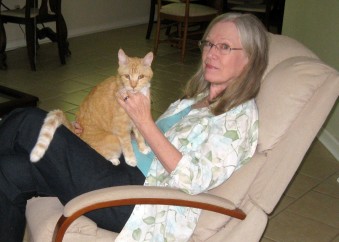I’m snuggling around my pillow in the dim glow of my bedroom, peacefully quiet and comfortable in a mound of soft quilts. It’s the last of winter in Southwest Florida, and the air is deliciously cool and fresh coming in the opened window. Around me wafts the sweet scent of orange blossoms from a neighbor’s tree, and my shoulders and neck relax as the day’s tensions leave me.
Suddenly there’s the pounce of another body in the bed, faint warmth presses against me, and I feel a hot breath on my neck. A nose rubs against my cheek. A moment later, a warm tongue licks my hair. “Victor,” I whisper.
No, this isn’t the start of a racy new romance. 
The other warm body is Victor, my yellow-haired cat, who likes to lick, nibble, tug, gnaw, and sometimes actually eat my hair, and then curl up on top of my head to sleep. That he purrs as he does this suggests he enjoys the routine.
Victor, who is somewhere between seventeen and nineteen years old, also prefers these hair-licking moments to occur during quiet times, often when my husband, Bill, or I least expect to have someone tugging on our hair.
Sneaking into bed is just one of his ways of licking a mouthful. He also likes to jump up on the back of the reading chair and get in a tug and chew when Bill settles in with a book. And forget a peaceful yoga workout; once Victor sees me on the floor, he assumes his own modification of the balasana (child’s pose) beside my head while nudging out a few strands of hair.
Inquiry into why Victor licks and sometimes eats hair resulted in some educational and ultimately reassuring information. He’s just socializing. Cats grooming each other is part of their way of getting along with other cats they might live with, and saying “we’re family.” While in the wild, most cats tend to be solitary animals, pet cats often live together. In these domestic groups, cats will lick, tug, and gently bite each other as part of their bonding process. Cats especially like to groom each other’s heads. The more grooming, the more affection, and the deeper the bonding.
While Victor is particularly fond of licking and tugging our hair, he never grooms our alpha cat, Mallory, also a rescue. Mallory was already in the house when we invited Victor into our home, and she stood her ground. They never bonded, though they never fight and are tolerant enough of each other to share toys, couches, and food bowls. Yet apparently, Victor chose to bond with Bill and me over Mallory.
We are assured, even flattered, that Victor’s grooming us is his way of saying we are his family. Yet eating hair—or other nonfood items—can be a sign of stress in a cat. Called pica, eating non-food items like hair, wool blankets, and plastic is a bit like obsessive-compulsive behavior in humans—and like OCD in humans, it can be triggered by trauma, stress, or a genetic predisposition.
Victor probably has some emotional scars. As a young cat, he was first rescued from a cat-hoarder situation severe enough to involved police. Years later, we rescued him again after he was abandoned in the hot Florida sun without food or water as an older cat. So, developing pica wouldn’t be that unexpected for Victor. Yet he does not display any of the other symptoms of pica– such as sucking wool blankets or clothes or rugs, and chewing or eating things like plastic bags, houseplants, wool, paper, rubber bands.
Eating hair and other non-food items can also be a sign of a dietary deficiency or even a serious illness. If your cat has odd eating habits, especially if this behavior comes on suddenly or represents a drastic change in behavior, please take your cat to a veterinarian.
If, as with Victor, it turns out merely to be your cat wants to groom you, then there are gentle steps one can take to end the practice if you find it annoying. Changing shampoo might be an easy step. We switched from a coconut-based shampoo, which did smell a bit like a pina colada, to a shampoo with mint. Victor apparently likes the mint as much as the coconut, so we switched to an unscented natural shampoo that has  no smell (at least to our limited human noses.) You guessed it—Victor likes that one too. And it could be that his special fondness for tugging and gnawing on our hair after a shower and shampoo is his way of refreshing his mark and scent on us.
no smell (at least to our limited human noses.) You guessed it—Victor likes that one too. And it could be that his special fondness for tugging and gnawing on our hair after a shower and shampoo is his way of refreshing his mark and scent on us.
Now we just relax when he tugs a bit of hair. Every cat we’ve ever had, and that’s a good many, has had some idiosyncrasies. It’s part of their charm.
And given the reassurance that Victor just wants to groom us as a way of saying we’re part of his family, we’ve come to view the hair licking and nibbling as his way of saying, “I love you.” And maybe, “thank you for rescuing me” from abandonment in his senior years.
We do, however, draw the line at licking his fur back.
Claire Hamner Matturro used to be a dog person, but then she rescued a tiny, black kitten out of a dumpster, and there was no going back. Today she lives in Florida with two rescued cats, Mallory and Victor, and her husband, Bill, who is definitely a cat person. She’s busily finishing up her Familiar Legacy manuscript, tentatively titled Trouble in Tallahassee, in which Familiar’s son, Trouble, becomes embroiled with a serial arsonist and the disappearance of a brilliant, but wild, young female law student. In Trouble in Tallahassee, Claire named the male protagonist Victor, after her own hair-nuzzling cat. Claire’s prior books are: Skinny-Dipping (2004) (a BookSense pick, Romantic Times’Best First Mystery, and nominated for a Barry Award); Wildcat Wine(2005) (nominated for a Georgia Writer of the Year Award); Bone Valley(2006) and Sweetheart Deal (2007) (winner of Romantic Times’ Toby Bromberg Award for Most Humorous Mystery), all published by William Morrow. Visit her at www.clairematturro.com

Love this blog!
LikeLiked by 1 person
What an awesome kitty. Lucky you that he chose you as his cat family.
LikeLiked by 1 person
Thanks for an informative post, Claire.
Victor looks like a yellow tabby, Sunshine, we had when I was a child. He was one of the best friends a kid could have. A few years after he passed away, we got another yellow tabby. He was orphaned when he was tiny and, while he never groomed our heads, he did love to suck on our earlobes.
LikeLike